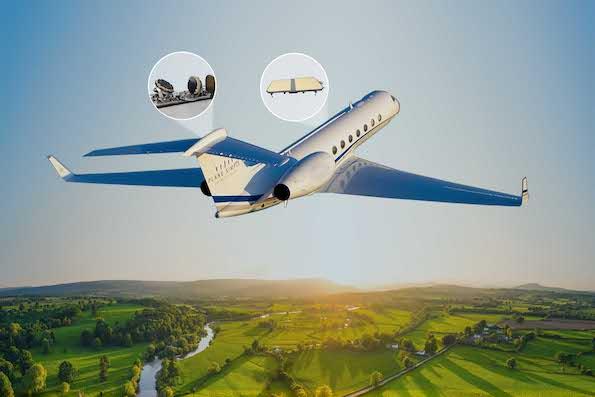
Avcon Jet is the launch customer for the SD Plane Simple electronically steered antenna.
Satcom Direct is offering its newly developed SD Plane Simple electronically steered antenna for a monthly fee, hoping to attract small business aircraft owners.
The plan covers the costs of the Satcom Direct (SD) hardware and connection to the Eutelsat OneWeb low-Earth-orbit (LEO) Ku-band satellite constellation, which will deliver speeds of up to 195 Mbps download to the airframe and 36 Mbps upload. The fully duplex terminal unlocks the full capability of the OneWeb LEO service, SD says.
The new portfolio of pricing plans includes several options, such as a three-year plan centered on a fixed monthly fee of $15,000, with no initial capital outlay.
“We know that smaller airframe owners are often more cost-conscious, run operations with just one or two aircraft and need services requiring minimal administrative management,” Satcom Direct President Chris Moore says. “Larger aircraft operators constantly seek enhanced fiscal management solutions. With our monthly pricing models, we are addressing both requirements.”
The low-profile flat-panel electronically steered antenna is particularly well suited for small aircraft, he added. Flight testing for the electronically steered antenna is scheduled to begin in August on a Cessna Citation Jet 1 and Cessna Caravan. Service entry is planned for the first quarter of 2025.
The electronically steered antenna terminal consists of two line replaceable units: the fuselage-mounted flat panel antenna and the modem unit. Built on an open architecture, the agnostic antenna designs reduce obsolescence by enabling simple upgrade pathways, SD says.
Austria-based private management specialist and aircraft operator Avcon Jet is the launch customer for the SD Plane Simple Electronically Steered Antenna. Avcon will equip multiple aircraft with the new antenna. It will also outfit aircraft with the SD Plane Simple Ku-band tail mount antenna powered by the Intelsat FlexExec air time, and the Ka-band tail mount variant, which connects with the Viasat Ka-band existing and next-generation satellites.
“With Avcon, we can demonstrate the advantages of working with the multifaceted Plane Simple portfolio of antenna systems to fulfill the demand for high-speed connectivity across a broad portfolio of airframes,” Moore says. Avcon operates more than 100 aircraft and holds air operator's certificates in 10 countries.
As connectivity has become vital for business aviation users, Moore recommended owners equip their aircraft with redundant systems. “We are the only one with multi-orbit offerings,” he says. “Typically, a large-cabin business jet can receive a tail-mounted installation for communications with a geostationary satellite and a fuselage-mounted antenna for a LEO orbit constellation.”
Internet speeds in LEO are growing and will reach 200 MB ultimately, providing full redundancy to work just as in an office, he emphasized.
“Having two systems on board ensures communications throughout the flight,” he says. “Sometimes, the geography or congestion prevents one system from working. None of the networks provides 100% availability. They usually promise the service is available 98% or 99% of the time. If you take into account the critical need for the customer in the passenger cabin, the reality is you need two systems. On ultra-long-range jets, with a CEO on board, a reliable system for 12-14 hr. of flight is essential.”





